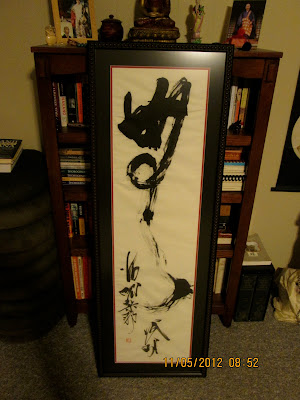The Kongo-kai or Vajradhatu Mandala of Shingon has at its core the Five Wisdoms. The following is Professor Hakeda's brief explanation of this essential teaching, which he refers to as the "Fivefold Wisdom symbolized by the Five Buddhas in the Diamond Realm."
1.) Wisdom That Perceives the Essential Nature of the World of Dharma (hokkai taisho chi); the eternal Source of gnosis, the Radiant, whose rays are to be differentiated in terms of the following four kinds of wisdom. Thus wisdom, represented by Mahavairocana, is located in the center of the Diamond Mandala.
2.) Mirrorlike Wisdom (daienkyo chi): the wisdom that reflects reality as it is without distortion. This wisdom is represented by Aksobhya (Ashuku), the Unshakable, located in the east.
3.) Wisdom of Equality (byodosho chi): the wisdom that perceives the fundamental identity of all phenomena as issuing forth from the One Reality and that recognizes the absolute equality of all beings as to their intrinsic value. It is represented by Ratnasambhava (Hosho), the Jewel Born, located in the south.
4.) Wisdom of Observation (myokanzatchi): the wisdom that observes the objects of mind free from discriminations and subjective calculations. It is represented by Amitabha (Amida), the Infinite Light, located in the west.
5.) Wisdom of Action (jososa chi): the wisdom that is manifested as actions to help bring all sentient beings to spiritual maturity and, finally, to enlightenment. It is represented by Amoghasiddhi (Fukujoju), the Infallible Realization, located in the north.
From "Kukai: Major Works" by Yoshito S. Hakeda, (Columbia University Press, 1972, p. 83 - 84)
Sunday, November 25, 2012
Monday, November 5, 2012
Perhaps the best "MU" ever...
During Ajari Tanaka's September visit we had a chance to review with him an incredible collection of his calligraphy that has amassed over the many years of his visits to Vermont. To our surprise Ajari seal stamped two pieces in the collection. Both were done during Ajari's autumn visits soon after he moved from Vermont back to Tokyo (1999), maybe 2000 or 2001.
Recently we have been able to frame one of these pieces. We think it's an amazing example of a character that Ajari Tanaka has done many times. It's on of our favorite "MU's".
We hope you like it too...
Subscribe to:
Comments (Atom)


